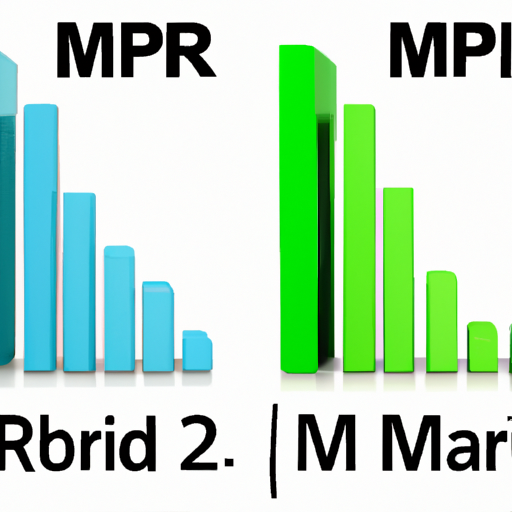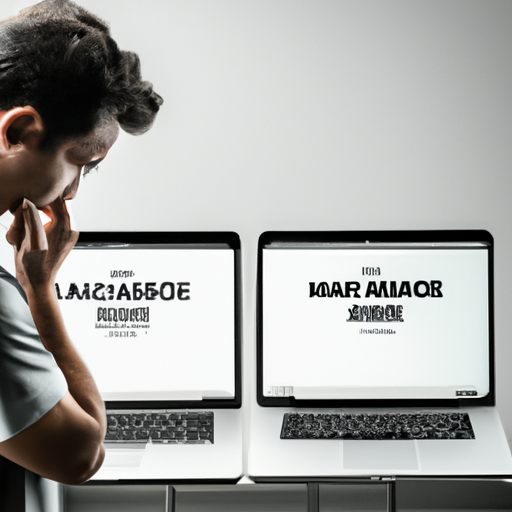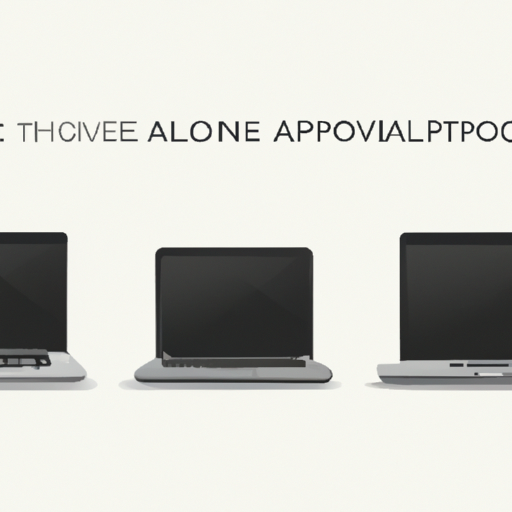Note: As an Amazon Associate we earn from qualifying purchases.
Deciding between a Macbook M2 Air vs Macbook M3 Pro (2023)
Introduction
I’ve been torn between the MacBook Air and MacBook Pro for a while now. Each has its merits, but it’s not always clear which is the right choice. I need something portable, yet powerful enough to handle my workload. Here’s what I’ve learned about choosing the right MacBook for your needs.
Prices
Check prices of the M3 Macbook Pro on:
Understanding Your Computing Needs – Air vs Pro
When choosing between a MacBook Air (MBA) and MacBook Pro (MBP), it’s crucial to assess what you actually need from your machine. I’ve gone through the dilemma myself, and here’s what I found. The MBA is incredibly light and portable, which makes it a favorite for students and professionals who are always on the move. Its performance, thanks to Apple’s M-series chips, is nothing to scoff at either. For everyday tasks such as browsing, document editing, and casual coding, the Air breezes through without a hiccup.
However, upgrading the Air with more RAM and storage brings its price dangerously close to the base model MBP. This is where you might consider making the jump, not merely for specs, but for the array of extras the Pro offers. The MBP’s Retina XDR display is a significant step up with its higher brightness levels and refresh rates, making everything from text to videos crisp and smooth. It’s not just the display—speakers are better, too, giving a richer audio experience, which is a pleasant perk for music lovers or when you’re streaming your favorite show.
One gripe I have with the MBA is its single external display support. As someone who values dual-monitor setups for multitasking, this limitation steers me towards the Pro, which effortlessly powers multiple screens. Moreover, if you dabble in more intensive tasks—be it professional-grade video editing, 3D modeling, or heavy computational work—the Pro’s active cooling system means it can sustain peak performance for longer without throttling under load.
The MBP also has a better selection of ports, which I appreciate since I prefer not living the dongle life. The HDMI port, SD card slot, and more Thunderbolt ports of the Pro add a lot of convenience. And while this might sound trivial to some, the feel of the Pro’s thicker, sturdier build gives a sense of durability—something you start to appreciate after a few years of use.
However, I can’t deny that the MBA’s design has its own charm. Its tapered shape and lighter build mean superior portability. Plus, the latest MBAs have an impressive battery life, so if your workload isn’t too demanding, this could be the clincher.
In terms of drawbacks, the Pro does cost more and is heavier, which might be a dealbreaker for mobile users. Ultimately, the decision boils down to evaluating the extra features against your actual usage patterns and mobility needs. Maybe you’re a light user today, but what about tomorrow? If you envisage creeping into more demanding computing territories, the versatility and power of the Pro might just be worth the investment.
Remember, whether it’s processing power, display quality, or system expansion, there’s a fairly significant overlap in capabilities with modern MacBooks. What I’ve outlined above isn’t rooted in benchmark stats but in real-world use and user convenience — and for many, that’s what dictates the better choice.
Performance Face-Off – M2 Air vs. M3 Pro

When it comes to choosing between the MacBook Air with the M2 chip and the MacBook Pro with the M3, there’s a spectrum of factors that sway the decision for someone like me, who’s into casual coding, a bit of 3D modeling, and general use. I’m particularly attracted to the M2 Air for its design and surprisingly good performance. It’s light, has a decent screen, and the battery life is stellar. I find myself comfortable with using one external display, and the Air’s fan-less design is a plus for quiet environments. The 24GB RAM option is overkill for many, but it’s nice for those extra Chrome tabs and light VM work.
However, I lean towards the M3 Pro for its raw power and versatility. I can’t ignore the satisfaction that comes from that extra horsepower when I compile code or render 3D models - tasks that can benefit from the M3’s higher core count and active cooling system. The screen is a step up with the ProMotion technology which offers a smoother visual experience, and when it comes to ports, having more than two is a luxury I appreciate.
The M3 Pro also has a 16-inch option, which is something to consider if screen real estate is important to you. That said, the price jump is significant when moving from the M2 Air to the M3 Pro, especially as you start looking at better specs like 36GB of RAM. As someone eyeing the middle ground, the M3 Pro 14” with the 18-core GPU and 24GB of RAM seems like a sweet spot. It’s powerful yet not as prohibitively expensive as the Max configurations.
While I understand the base models might attract users due to the lower price point, I’m wary of the limited 8GB RAM in the entry-level Pro—multitasking and future demands can likely exceed its capabilities. Storage, too, is a consideration; 512GB is a practical starting point, but I gravitate towards 1TB for comfort, especially when dealing with large files.
In essence, the line blurs when it comes to the performance differences between the Air and Pro models for everyday users. But when you’re someone who occasionally dabbles in more intensive tasks, that line becomes clearer. The Air might punch above its weight, but the Pro has the might to not just punch, but to knock out heavier workloads.
Given that we’re just talking about performance here, it’s about weighing the raw speed and future utility of the M3 Pro against the more than capable, less pricey, and slightly less versatile M2 Air. I can acknowledge the drawbacks like the Pro’s heftier weight and higher cost, but the gains in performance and capability often tip the scales in its favor for power users.
For those coders, creators, or even data science students out there, keep in mind that compiling large projects or running heavy simulations will appreciate the M3 Pro’s might. Yet the M2 Air should not be quickly dismissed if your tasks are less demanding. Each has its merits, and for me, it’s a matter of deciding where on the spectrum of power, portability, and price my exact needs fall.
Design and Portability – Travelling Light or Going Pro
Choosing between the sleek MacBook Air and the robust MacBook Pro goes beyond raw specs; it’s a reflection of lifestyle, work habits, and personal preferences. Having used both models, I find that portability and design are key differentiators that affect daily use. The Air, with its feather-light build, is a no-brainer for those who prioritize a laptop that vanishes into a backpack, perfect for hopping from lecture halls to coffee shops. Its thin profile and silent, fanless operation are compelling, especially in quiet environments where even the slight whir of a fan might be disruptive.
Despite its allure, the Air does set boundaries on functionality. The single external display limitation can be a deal breaker for those used to sprawling digital workspaces across multiple monitors. While third-party docks offer a workaround, they’re an added expense and another piece of gear to carry – not ideal for the true minimalist. For coders and creators, this might be an acceptable trade-off, given how capable even the base Air model is for most development tasks.
On the other hand, the MacBook Pro ushers in a different mindset. It leans into the ‘Pro’ moniker not just through higher specs, but with a design that acknowledges and facilitates complex workflows. The addition of an HDMI port and an SD card slot, alongside multiple Thunderbolt ports, directly acknowledges the Pro user who frequently interfaces with external peripherals and values direct, dongle-free connectivity. The heftier build and the ever-so-satisfying MagSafe charging snap are subtle acknowledgments that this machine means business.
The brighter, high-refresh-rate Mini LED display on the MacBook Pro is a tangible upgrade. While the Air’s screen is undoubtedly sharp and capable, the Pro’s display makes color-grading sessions and late-night coding marathons less of a strain on the eyes. And let’s be honest, the allure of ProMotion technology and those deep blacks really appeal to both the aesthetic enthusiast and the professional editor alike.
Yet, it’s not all sunshine with the Pro. The added weight compared to the Air does become noticeable after a day of traversing a campus or commuting. Moreover, the Pro’s active cooling system, while keeping performance thermal-throttle-free, does introduce noise – a factor to consider if your environment demands silence.
In terms of design, the MacBook Pro’s notch—yes, a notch on a laptop—is a peculiar design choice that, while expanding screen real estate, can be a distraction until you grow accustomed to it. The Air’s notch-free design therefore tends to feel more harmonious to some users.
Ultimately, both machines are stylish, flaunting that quintessential Apple aesthetic; however, choosing between the Air and the Pro is as much about how you move through your day as it is about technical needs. Do you need a command center on the go, equipped with a full array of ports and a screen that doubles as a portable cinema? Or is the svelte simplicity of the Air, with its all-day battery life and barely-there presence in your bag, more your speed? As a part of daily carry, these considerations are as important as what’s under the hood.
Budget and Value for Money – Where to Invest

When it comes to assessing budget and value for money in the MacBook ecosystem, I’ve observed that choices are often more about personal use cases than raw specs alone. For many potential buyers, the allure of the MacBook Pro, with its additional power and features, might seem like a no-brainer. However, I’ve come to believe that it’s crucial to weigh the actual utility of these features against their cost.
Starting with the MacBook Air, it’s undeniable that for a typical user, especially a student or someone who doesn’t engage in high-intensity tasks, the Air is often more than adequate. With a possible configuration of 24GB RAM and 1TB SSD, one could argue that it’s a machine that punches well above its weight. The M2 iteration of the Air, priced at around USD 1915 for this setup, delivers a compelling proposition for those who need a great balance of performance and price. But that’s where context matters; if you’re not consistently pushing your machine to the limit with tasks like video editing or 3D modeling, the Air’s limitations around things like external display support may not be a dealbreaker.
On the flip side, the MacBook Pro with the M3 chip starts to make sense when considering the type of workload that would benefit from the extra investment. While the base model Pro can climb up to USD 2300, that cost brings with it not just hardware improvements but nuances like enhanced thermals, a brighter and more color-accurate display, and better speaker quality. The difference in cost is not trivial, but for the power users among us, those enhancements amount to more than just luxury—they’re about efficiency and longevity. The option to configure a Pro with up to 36GB of RAM might feel like overkill today, but considering the ever-growing demands of applications, it comes with a certain peace of mind about future viability.
One of the key drawbacks of opting for higher-end models is, obviously, the hit to the wallet. While I might edge towards a more power-packed Pro, I’m acutely aware that I may be paying for performance I don’t strictly need. And sure, the M3 Pro’s enhanced GPU performance is tempting, but it adds to the cost, nudging it closer to the territory where one starts to consider more stationary options like the Mac Studio for substantial computational needs. But when portability is a must, this trade-off is often worthwhile.
To sum up, although the MacBook Air is often seen as the entry point into macOS, it’s a deceptively powerful machine, especially when upgraded—and for many, that upgrade represents the sweet spot of value. The Pro is undoubtedly a workhorse for creative professionals and those needing sustained performance, but the question remains: does its higher cost equate to better value for everyone? The answer isn’t absolute and harks back to individual need and preference. Deciding where to invest is thus not merely a comparison of specs and prices but a reflection on personal usage patterns, projected needs, and whether the premium features of the Pro genuinely enhance one’s workflow or are just ‘nice to have’.
In the context of evaluating budget against needs, I think back to the old computing adage: buy the best you can afford, but only if you’re going to use it to its full potential. If not, the Air with a boost in RAM and storage may very well be the wisest investment, allowing you to allocate funds to other areas, like accessories or software that could further enhance your productivity and experience.
Future-Proofing – Thinking Ahead

Choosing the right MacBook for your needs often feels like trying to predict the future. Do you invest more money now in a Pro model, hoping it will meet your ever-evolving demands, or save money with an Air model that caters to your current light usage? As a software developer who occasionally dabbles in photo and video editing, I’ve faced this dilemma first-hand.
Firstly, it’s crucial to consider the longevity of your computing hardware. A Pro model, with its better thermals from active cooling systems, can handle intensive tasks like video processing or 3D modeling without breaking a sweat (Apple’s comparison). Plus, the additional ports are a boon for professionals juggling multiple peripherals. In my experience, options like the 14-inch MacBook Pro, which bridges the gap between portability and power, offer a compelling reason to go Pro. The higher memory configurations - while pricey - provide me peace of mind, knowing I won’t be hamstrung by insufficient RAM when running complex Docker containers or keeping dozens of browser tabs open.
On the flip side, the MacBook Air is no slouch. The M2 variant, with its improved performance over the M1, is well-suited for casual users and even some professionals (M2 benchmarks). I’ve seen the Air handle high-level programming languages and IDEs with surprising finesse. And for those who prioritize a light and thin design, the Air remains unmatched. But make no mistake, the Air’s inability to support multiple external monitors out of the box could be a deal-breaker for some, including myself. I find this capability essential for multitasking and productivity.
It’s worth noting that upgrading the Air with more RAM and SSD storage starts to narrow the price gap with the base Pro models. This is where “future-proofing” really kicks in. I’ve learned that while specs are important, so too is the quality of the display and speakers if your MacBook is your primary entertainment device. The Pro’s mini-LED display, high refresh rates, and superior audio are tangible upgrades that enhance daily use (Pro Display XDR).
In conclusion, my advice leans slightly towards the Pro models, particularly if you’re keen on a machine that will hold its value and capability over a longer period. But for light users who seldom push their machines to the limits, a well-configured Air is more than adequate and is a joy to carry around. Both choices are justifiable, but in a world where digital demands are only increasing, the Pro is a formidable companion that’s tough to outgrow.
Determining the right MacBook is a highly personal choice, influenced by anticipated future needs, workflow complexity, and budget constraints. Take it from someone who’s oscillated between the two: it pays to look forward - but only just so far as to not overestimate your necessities or underestimate the potential of more modest hardware. Remember, the best MacBook is the one that matches your current lifestyle while providing a tiny bit of headroom for the unexpected.